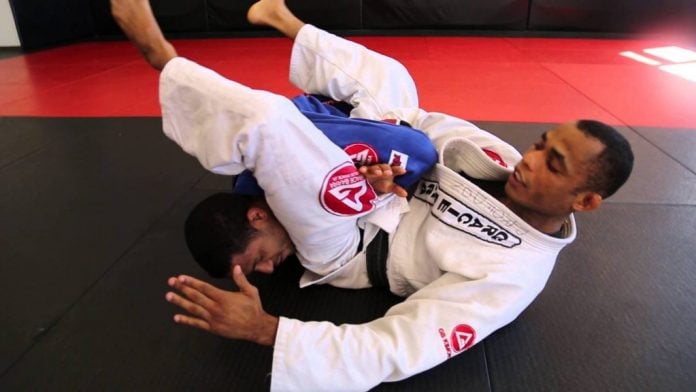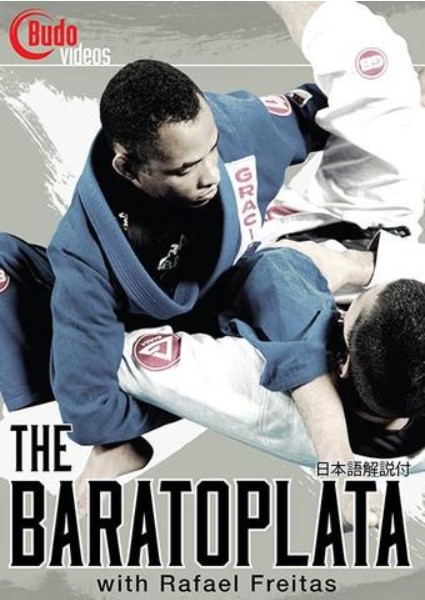
Every now an then the world of Brazilian Jiu-Jitsu is exposed to a new submission. Some these innovative submission turn out to be just a waste of time. Others, however, are game-changing moves that re-shape the world of grappling martial arts as we know it. So when an established Gracie Barra black belt and a top competitor comes up with an unorthodox submission, you can assume it is legitimate. Furthermore, once it’s proven in competition at all levels, you can rest assured it’s effective. Such is the case of the Baratoplata shoulder lock.

The Baratoplata is a quite unusual and very effective submission created by a Brazilian black belt. Rafael “Barata” Freitas is the person behind the move, as his nickname suggests. The submission is, in essence, a shoulder lock. It bears certain similarities to the omoplata, hence the “plata” adjacent to Rafel’s nickname. It might be considered as a reverse-grip omoplata of a kind. Let’s take a look at how this move came to be, and how to add it to your submission arsenal.
Speaking of a submission arsenal, check out the Highest Percentage MOves Of Jiu-Jitsu.
Rafel “Barata” Freitas
Rafael de Freitas is a Brazilian Jiu-Jitsu black belt, from the Gracie Barra lineage. He is an accomplished competitor with titles from the No-Gi Worlds and the Pan Ams. He’s also a professional MMA fighter with a great record.
Barata (which, by the way, means “cockroach”) was born in Brasilia. A capoeira practitioner since the early age of 5, he’s been involved in martial arts his whole life. Barata started BJJ under Alison Brites, in Brasilia. He first came up with the Baratoplata during his purple belt days. At first, it was a biceps slicer of sorts, that the small Brazilian later perfected into a shoulder lock. This was largely due to the INJJF rules that consider biceps slicers illegal until black belt.
Barate received his black belt from Carlos Gracie Junior in 2008. He currently teaches at the Gracie Barra academy in New Mexico.
Mechanics of the Baratoplata
As we said, the Baratoplata is primarily a shoulder lock. It is based on isolation of the shoulder joint via immobilization of the elbow. The breaking pressure of the lock is applied by moving the wrist in an outside direction. Another manner of finishing is to move the elbow and wrist in opposite directions at the same time.
Positionally, the Baratoplata is done with both the legs and arms. A key point is to trap the opponent’s elbow between your legs. One of your arms should be thread behind the opponent’s elbow, with the palm grasping your own thigh. This places their elbow pointed at your chin and the shoulder and aligns their shoulder and wrist. Pressure is loaded by rotating the body towards the opposite side of the opponent’s body. Lifting the arm is the final detail to a tight and painful Baratoplata.
Bottom Attacks
Primarily, the Baratoplata is a submission done from the bottom. It is often set up from the full guard to great success. To begin with, you should look for a reverse kimura grip on one of your opponent’s arms. Next, you should force their wrist toward their belly, at the level of the belly button. After trapping the arm, the foot of your leg that’s on the same side as the arm you’re attacking should go onto the opponent’s hip. The leg needs to stay tight to their body at all times.
Once the leg is controlling the hip, you place your arm through the loop you’ve made by forcing the opponent’s wrist into their belly. It should end up in the crook of their elbow. The palm of the hand that goes through ends up on your own thigh, providing strong gripping control.
Finishing from the guard requires a slight change of angle before breaking mechanics are applied. To obtain this, you need to shift your upper body to the side, similar to finishing a triangle choke. This will position you under your opponent’s body at an optimal angle to finish the Baratoplata. From there, you finish by applying pressure with your arm and keeping your legs tight to control the opponent’s posture and restrict movement. The submission comes on quick and is very painful.
Looking for more BJJ Guard Attacks? Here’s a very useful article you can check out.
Hunting From The Top
Although setting up the Baratoplata is most common from the guard, it can be attacked from a multitude of positions. In terms of top positions, the mount is probably the best position to hunt Baratoplatas from. Side control is also an option, allowing you to string the Baratoplata with other far side arm attacks.
Mount
From the mount, the Baratoplata is set up similarly to hunting an armbar. It is actually a great option to fall back to when an opponent defends armbar attempts. When the opponent has their arms crossed it puts you in a perfect spot for the submission. First, you need to thread your arm through and get a tight grip on their top wrist. Next, you lift your same side leg to get into a sort of S-mount position. From there, a cool half-spinning move is going to get you the leg position we covered before in the full guard setup. Actually finishing the submission from the full guard is the best way to ensure a tight Baratoplata. For a fast finish of the top, just underhook the opponent’s free arm and lift your hips.
Side Control
From topside control, the Baratoplata is great in combination with far side Kimuras and armbars. Namely, every time you get your opponent facing towards you, with a grip on their top arm you’re all set for the Baratoplata. You just pull your opponent towards you as if going for a far side armbar. Instead of stepping over their head and rotating for the armbar, though, you just place your leg in an S-mount like structure and throw the other leg around the arm. You’ll end up on the bottom, but you’ll have a tight shoulder lock all set to go. Often, you’ll get the tap in transition. Furthermore, you can always go back to armbars or hunt for triangles from the position.


![Darce Choke Encyclopedia – Origins, Mechanics and Variations [2025] BJJ, choke, Brabo, BJJ Darce Choke, D'arce Choke, Darce BJJ Choke](https://bjj-world.com/wp-content/uploads/2017/11/JungPoirierLeeYahoo-218x150.jpg)













![Jiu-Jitsu For Old Guys Guard Retention Bernardo Faria DVD Review [2025] Jiu-Jitsu For Old Guys Guard Retention Bernardo Faria DVD Review](https://bjj-world.com/wp-content/uploads/2025/03/old-guys-guard-retention-bernardo-faria-dvd-review-218x150.png)
![X-Guard Trickery Kyle Sleeman DVD Review [2025] X-Guard Trickery Kyle Sleeman DVD Review](https://bjj-world.com/wp-content/uploads/2025/03/x-guard-trickery-kyle-sleeman-dvd-review-218x150.png)
![Countering with Crab Ride Anthony Budion DVD Review [2025] Countering with Crab Ride Anthony Budion DVD Review](https://bjj-world.com/wp-content/uploads/2025/03/countering-with-crab-ride-anthony-budion-dvd-review-218x150.png)
![Closet Closed Guard Craig Jones DVD Review [2025] Closet Closed Guard Craig Jones DVD Review](https://bjj-world.com/wp-content/uploads/2025/03/closet-closed-guard-craig-jones-dvd-review-218x150.png)
![Xanadu Back Takes Levi Jones-Leary DVD Review [2025] Xanadu Back Takes Levi Jones-Leary DVD Review](https://bjj-world.com/wp-content/uploads/2025/03/xanadu-back-takes-levi-jones-leary-dvd-review-218x150.png)

![The Rack Kyle Watson BJJ DVD Review [2025] The Rack Kyle Watson BJJ DVD Review](https://bjj-world.com/wp-content/uploads/2024/12/the-rack-kyle-watson-bjj-dvd-review-324x235.png)
![The Empty Half Guard Michael Currier DVD Review [2025] The Empty Half Guard Michael Currier DVD Review](https://bjj-world.com/wp-content/uploads/2025/03/empty-half-guard-michael-currier-dvd-review-100x70.png)



![Essential Shin To Shin System Shawn Williams DVD Review [2025] Essential Shin To Shin System Shawn Williams DVD Review](https://bjj-world.com/wp-content/uploads/2025/01/shin-to-shin-system-shawn-williams-dvd-review-100x70.png)
![Nicholas Meregali No-Gi System DVD Unpacked: A Detailed Review [2024] Nicholas Meregali No-Gi System DVD Unpacked: A Detailed Review](https://bjj-world.com/wp-content/uploads/2024/09/nicholas-meregali-no-gi-system-dvd-unpacked-review-100x70.png)

![Finish on the Back Ethan Crelinsten DVD Review [2024] Finish on the Back Ethan Crelinsten DVD Review](https://bjj-world.com/wp-content/uploads/2024/10/finish-on-the-back-ethan-crelinsten-dvd-review-100x70.png)



![How to Double Leg Anyone Kevin Lee DVD Review [2024] How to Double Leg Anyone Kevin Lee DVD Review](https://bjj-world.com/wp-content/uploads/2024/11/how-to-double-leg-anyone-kevin-lee-dvd-review-100x70.png)
![EMU Guard 2.0 Benjamin Power DVD Review [2024] EMU Guard 2.0 Benjamin Power DVD Review](https://bjj-world.com/wp-content/uploads/2024/11/emu-guard-2-0-benjamin-power-dvd-review-100x70.png)
![Breaking Their Guard Mikey Musumeci DVD Review [2025] Breaking Their Guard Mikey Musumeci DVD Review](https://bjj-world.com/wp-content/uploads/2025/02/breaking-their-guard-mikey-musumeci-dvd-review-100x70.png)
![Advanced Chin Control Concepts David Petrone DVD Review [2025] Advanced Chin Control Concepts David Petrone DVD Review](https://bjj-world.com/wp-content/uploads/2025/01/chin-control-concepts-david-petrone-dvd-review-100x70.png)
![Lockdown Quickstart Guide Cameron Mellott DVD Review [2025] Lockdown Quickstart Guide Cameron Mellott DVD Review](https://bjj-world.com/wp-content/uploads/2025/03/lockdown-quickstart-guide-cameron-mellott-dvd-review-100x70.png)
![The Stack Pass Andre Galvao DVD Review [2025] The Stack Pass Andre Galvao DVD Review](https://bjj-world.com/wp-content/uploads/2025/01/the-stack-pass-andre-galvao-dvd-review-100x70.png)
![360 Degrees Guard Retention Thiago Abud DVD Review [2024] 360 Degrees Guard Retention Thiago Abud DVD Review](https://bjj-world.com/wp-content/uploads/2024/10/360-degrees-guard-retention-thiago-abud-dvd-review-100x70.png)
![Master The Move Anaconda Strangle John Danaher DVD Review [2025] Master The Move Anaconda Strangle John Danaher DVD Review](https://bjj-world.com/wp-content/uploads/2025/02/anaconda-strangle-john-danaher-dvd-review-100x70.png)

![Guard Busters Bill Cooper BJJ DVD Review [2025] Guard Busters Bill Cooper BJJ DVD Review](https://bjj-world.com/wp-content/uploads/2025/03/guard-busters-bill-cooper-bjj-dvd-review-100x70.png)
![Old School BJJ Ricardo Cavalcanti Fundamentals DVD Review [2024] Old School BJJ Ricardo Cavalcanti Fundamentals DVD Review](https://bjj-world.com/wp-content/uploads/2024/09/old-school-bjj-ricardo-cavalcanti-dvd-preview-100x70.png)
![Mastering Control From Top Position Trent Hidlay DVD Review [2024] Mastering Control From Top Position Trent Hidlay DVD Review](https://bjj-world.com/wp-content/uploads/2024/11/control-from-top-position-trent-hidlay-dvd-review-100x70.png)

![Osoto Gari for Jiu Jitsu Jackson Nagai DVD Review [2024] Osoto Gari for Jiu Jitsu Jackson Nagai DVD Review](https://bjj-world.com/wp-content/uploads/2024/10/osoto-gari-for-jiu-jitsu-jackson-nagai-dvd-review-100x70.png)

![Roger Gracie Guard Passing System DVD Review [2025] Roger Gracie Guard Passing System DVD Review](https://bjj-world.com/wp-content/uploads/2025/02/roger-gracie-guard-passing-system-dvd-review-100x70.png)
![Top Half Guard Neil Melanson DVD Review [2025] Top Half Guard Neil Melanson DVD Review](https://bjj-world.com/wp-content/uploads/2025/02/top-half-guard-neil-melanson-dvd-review-100x70.png)